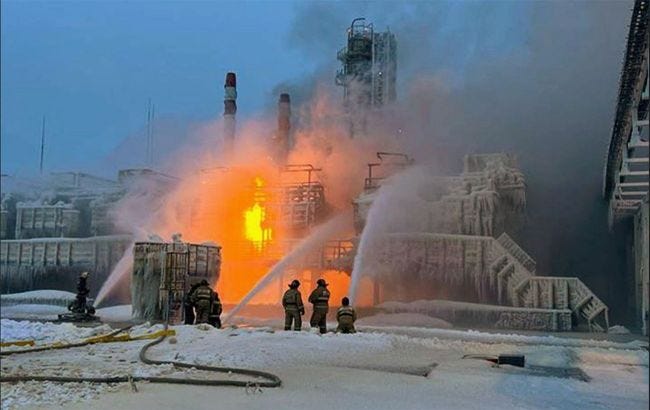The Blame Game
The state of the US-Russia-Ukraine ceasefire negotiations
An oil refinery in Krasnodar Krai following an attack by Ukrainian drones.
Was progress towards at least a partial ceasefire between Russia and Ukraine made in Saudi Arabia on Monday? At first glance it seems so. As announced on Tuesday, there was an agreement to ‘ensure safe navigation, eliminate the use of force, and prevent the use of commercial vessels for military purposes’ in the Black Sea. In addition discussions are to continue on ending attacks on energy infrastructure. Yet as soon as these were announced questions were raised about scope and schedule. Conditions began to be applied. It is not yet clear when and if they will ever come into force.
In my previous post, written after President Zelenskyy had agreed to a full ceasefire, including land forces, and the US had insisted that the ball was now in President Putin’s court, I expressed doubt about whether this was something the Russian leader could agreed to. Instead I suggested that he would:
‘string the discussions along to see if he can extract more from the Americans, perhaps some sanctions relief, and even if this effort fails he can at least claim he was doing his best to find a way forward.’
This is what he has been doing, so far successfully.
In this post I will examine how this has been done, and to what extent the Trump administration is complicit. I am aware of regular assertions that Trump is virtually Putin’s agent. Without denying the credulity and sympathy with which Trump and some of his aides have treated many of Putin’s claims, I think this is too simplistic. While clearly some close to Trump (Vance, Musk, Witkoff, Trump Jr.) are hostile to Ukraine, this is not true of other key players (Waltz, Rubio, Kellogg).
Moreover, Trump himself blows hot and cold. After the melt down in the Oval Office at the end of February, relations have been restored (as well as military supplies and intelligence). If we assume he wants at least a ceasefire that stops the fighting as soon as possible then he needs Ukraine on side. Because of this, he wants to believe that Putin shares this objective, although this is evidently not the case.
Will this impatient administration come to realise that the eminently reasonable Putin with which it claims to be dealing is a mythical figure? Will there come a point when the reality of Putin’s position becomes impossible to ignore, or will the administration stay satisfied with apparent concessions sufficient to keep the process going? Putin’s approach to negotiations is familiar from the Soviet days, pocketing any concessions while offering few of his own, and then only slowly, and with conditions.
While the current diplomatic effort is, in principle, about trying to find a way to end the war, in practice it is also about avoiding the blame for its likely failure. If the incentives to avoiding blame are high enough, so that the belligerents make more concessions than might otherwise have been the case, then this can work to the benefit of the peace process. Nonetheless, if both sides are working on the assumption that there will be no grand deal, and that the war will continue, they will use the process to get into the best position for the next round of fighting. The prize for Putin should Trump blame Zelenskyy is that Ukraine will be abandoned by the US: for Ukraine the vital objective is avoiding that fate while encouraging Trump to step up sanctions on Russia.
Keep reading with a 7-day free trial
Subscribe to Comment is Freed to keep reading this post and get 7 days of free access to the full post archives.


